#MARS RIVERS! MARS DELTAS! MARS OCEANS
Explore tagged Tumblr posts
Text
DID MARS EVER CONTAIN WATER??
Blog#428
Saturday, August 17th, 2024.
Welcome back,
While the icy moons of Jupiter and Saturn contain water, Mars remains dry. Despite dozens of space missions, the Red Planet has yet to provide convincing proof that it conceals significant water reserves beneath its surface.
Yet Earth's little cousin hasn't always been so secretive. Various studies have shown that a little over 4 billion years ago, it experienced a "watery" era when lakes, rivers and perhaps even oceans could maintain themselves on its soil. Branching valleys and ancient terrains rich in hydrated clays are evidence of this blissful period of abundance.
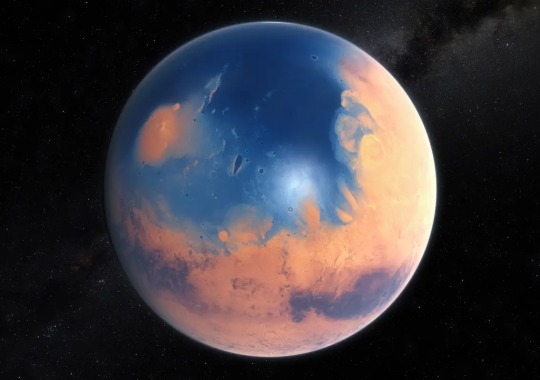
Subsequently, the loss of part of the Martian atmosphere led to a reduction in the greenhouse effect followed by a gradual disappearance of water. The question is how long this process lasted and under what conditions. This is what the American Space Agency's (NASA) Curiosity and Perseverance spacecraft have been trying to establish since their arrival in 2012 and 2021 in the Gale and Jezero craters.
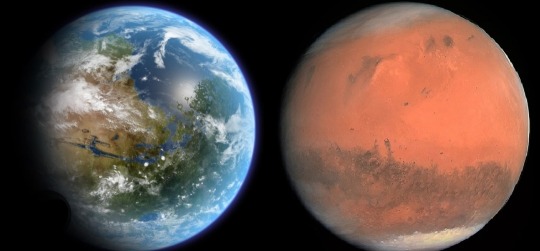
"Lakes occupied these depressions 3.5 or 3.6 billion years ago," explained Nicolas Mangold, a director of research at the French National Center for Scientific Research (CNRS) Laboratory of Planetology and Geosciences in Nantes.
By studying the sedimentary and clay deposits left by the former and exploring the ancient river delta that fed the latter, the aim is to determine whether the climate at the time was wet and cold, or dry and hot. The Perseverance rover is also collecting samples, to be brought back to Earth as part of the MSR mission [Mars Sample Return, NASA-European Space Agency (ESA)]. They should provide precise information."
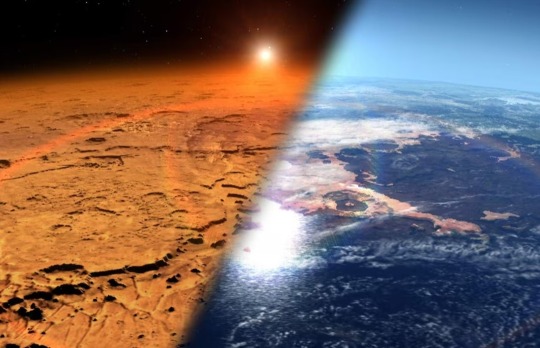
For the moment, things are hazy. If water has flowed on Mars, where has it gone? Was it sucked up into space with the Martian atmosphere or did some of it remain on site, buried underground? Many teams around the world are working to find answers by searching for clues to its presence other than those offered by polar ice caps and glaciers.
As water cannot remain in a liquid state for long on the surface of Mars, these investigations often consist of spotting recent traces of its passage using instruments placed in orbit. This opens the way to all kinds of controversy about how to interpret observations of this world, whose morphology is radically different from that of Earth. "Some of these controversies, such as those concerning gullies – ravines 1 or 2 kilometers long, discovered by the hundreds along certain landforms in the early 2000s – have finally been settled," said Susan Conway, a CNRS researcher at the Laboratory of Planetology and Geosciences in Nantes.

Her team recently demonstrated in the journal Nature Communications that seasonal deposits of dry ice explain the phenomenon, and not water flows.
Other clues continue to fuel debate and even controversy among scientists. The nature of "equatorial dark flows," the background noise of radar signals suggesting the existence of an underground sea beneath the North Cap, the presence of possible channels in the ejecta of impact craters and the hypothetical formation of "rides" in areas of glacial retreat. If water exists on Mars, it is well camouflaged.

Why not deep underground, frozen in the cryosphere? Or preserved in liquid form in aquifers, or inside the thin film of perchlorate brine that supposedly exists at the base of the permafrost that covers Mars at high latitudes? The Marsis and Sharad radars of the Mars Express (ESA) and MRO (NASA) probes have pinpointed promising regions. And when NASA's Phoenix lander dug a few centimeters into the frozen ground just after it arrived in 2008, it immediately uncovered blocks of water ice – a further reason for hypothesis and speculation.
Originally published on https://www.lemonde.fr
COMING UP!!
(Wednesday, August 21st, 2024)
"DID LIFE EXIST ON VENUS??"
#astronomy#outer space#alternate universe#astrophysics#universe#spacecraft#white universe#space#parallel universe#astrophotography
81 notes
·
View notes
Note
The sun is the center of our solar system
As a giant ball of plasma it’s pretty hard to miss him
In its 30 million degree center u would see
Hydrogen fuse into helium and release energy
Magnetic fields cause solar flares and coronal mass ejections
And particles from these burst damage electronic connection
It’s 100 times wide as earth and 93 Million mikes far
And despite all of this it’s just an average sized star
Mercury
Venus
Earth and mars
They’re the first four planets
Rocky like ours
Jupiter
Saturn
Uranus and Neptune
They’re made of hydrogen and helium
Gas like a ballon
Mercury is the closet planet to the sun
And as suck it takes the least time to run
Around its year is only 88 earth days
And the solar winds means that little gas stays
On its rocky surface; barren and full of craters
With no atmosphere it’s temperature waivers
From 800 Fahrenheit to minus 300 at night
But there is still some ice in craters away from the light
Mercury
Venus
Earth and mars
They’re the first four planets
Rocky like ours
Jupiter
Saturn
Uranus and Neptune
They’re made of hydrogen and helium gas like a ballon
Venus is the second planet from the sun
It’s the same size as earth…give it take some
Venus is covered in a thick layer of clouds
Made of carbon dioxide which in effects shrouds
The planet from losing heat like a giant blanket
So it’s 900 degrees due to the green house effect
It’s covered with volcanos and is shaped by their power
And the only probes that have ever landed died in with 2 hours
Mercury
Venus
Earth and mars
They’re the first four planets
Rocky like ours
Jupiter
Saturn
Uranus and Neptune
They’re made of hydrogen and helium gas like a ballon
The earth is the third planet from the sun
…I gotta feeling ur familiar about this one
It’s the only to know to have had life in its history
Though just how life started is still a bit of mystery
4 Billion years ago two protoplanets collided
And our moon was formed when collision debris United
Earth sun the Goldilocks zone but to hot nor to cold
For liquid water to exists and life as we know it to take hold
Mercury
Venus
Earth and mars
They’re the first four planets Rocky like ours
Jupiter
Saturn
Uranus and Neptune
Are made of hydrogen and helium gas like a ballon
Mars is the fourth planet from the sun
And it’s the place to where our voyage to other planets has begun
The surface is covered with red iron oxide
And much of its atmosphere was blow away with no magnetic field inside
Early astronomers saw canals everywhere
And they thought perhaps aliens had put them there
Thanks to telescopes orbiters and rovers we now know
That there are no suck alien canals although
Rivers deltas volcanoes and canyons abound
There little water left but life on mars may still be found
So we send space craft there like curiosity
To try to understand mars geologic history
(I skipped this little part:3)
Jupiter is the fifth planet it’s the largest one
Bigger than all the others combined
But only one thousand of the sun
It’s a gas giant so it has no ground on which to stand
But that DOSENT mean it’s surface is bland
The Great Red Spot is a giant cyclone if it’s surface
It’s centuries old and huge bigger than the earth is
There are four big moons with binoculars you can see
Discovered in 1610 by Galileo Galilei
Io has volcanos heated by the friction of its tide
And Eroupas covered in ice with a ocean inside
Ganymede is the largest moon we know exists
And Callisto covered in craters from the asteroids it hits
Mercury
Venus
Earth and mars
They’re the first four planets
Rocky like ours
Jupiter
Saturn
Uranus and Neptune
They’re made of hydrogen and helium gas like a ballon
Saturn is the sixth planet from the sun
In terms of beauty if Stau it’s Rings have clearly won
They’re mad of bust of ice and rocks orbiting through the void
And they may have been formed when a moon was destroyed
Saturn is the least dense of any planet know
And the mist oblate it’s centrifugal
Force is really shown
Titan has methane lakes and a thick orange haze
And Enceladus(salad) has water in liquid phase
Mercury
Venus
Earth and mars
They’re the first four planets
Rocky like ours
Jupiter
Saturn
Uranus and Neptune
They’re made of hydrogen and helium gas like a ballon
Uranus is the seventh planet from the sun
And dirty jokes about its name are deserving of SHUN!
Not much is know about Uranus or it’s brother Neptune
Cuz voyager 2 was the only craft to go to them
Uranus has rings though not as great as Saturns
And it’s usually devour of any interesting patterns
There not much more about this place which I can say
But hopefully we’ll send a new space craft there someday
Mercury
Venus
Earth and mars
They’re the first four planets
Rocky like ours
Jupiter
Saturn
Uranus and Neptune
They’re made of hydrogen and helium gas like a ballon
Neptune is the eighth and final planet from our star
The suns .1% as bright because it is so far
It’s similar tor Uranus in mass size and composition
And Uranus orbit predicted its position
U may have noticed Neptune is a bright blue
The methane in its atmosphere gives Neptune its hue
Ist the windest with 1000 mile per hour at wind gust
And triton has liquid nitrogen spewing from its crust
WOW
CLAPS LOUDLY
THATS BEAUTIFUL THANK YOU ❗❗❗❗❗❗🙏🙏🙏🙏🙏🙏🙏
26 notes
·
View notes
Note
The sun is the center of our solar system
As a giant ball of plasma it’s pretty hard to miss him
In its 30 million degree center u would see
Hydrogen fuse into helium and release energy
Magnetic fields cause solar flares and coronal mass ejections
And particles from these burst damage electronic connection
It’s 100 times wide as earth and 93 Million mikes far
And despite all of this it’s just an average sized star
Mercury
Venus
Earth and mars
They’re the first four planets
Rocky like ours
Jupiter
Saturn
Uranus and Neptune
They’re made of hydrogen and helium
Gas like a ballon
Mercury is the closet planet to the sun
And as suck it takes the least time to run
Around its year is only 88 earth days
And the solar winds means that little gas stays
On its rocky surface; barren and full of craters
With no atmosphere it’s temperature waivers
From 800 Fahrenheit to minus 300 at night
But there is still some ice in craters away from the light
Mercury
Venus
Earth and mars
They’re the first four planets
Rocky like ours
Jupiter
Saturn
Uranus and Neptune
They’re made of hydrogen and helium gas like a ballon
Venus is the second planet from the sun
It’s the same size as earth…give it take some
Venus is covered in a thick layer of clouds
Made of carbon dioxide which in effects shrouds
The planet from losing heat like a giant blanket
So it’s 900 degrees due to the green house effect
It’s covered with volcanos and is shaped by their power
And the only probes that have ever landed died in with 2 hours
Mercury
Venus
Earth and mars
They’re the first four planets
Rocky like ours
Jupiter
Saturn
Uranus and Neptune
They’re made of hydrogen and helium gas like a ballon
The earth is the third planet from the sun
…I gotta feeling ur familiar about this one
It’s the only to know to have had life in its history
Though just how life started is still a bit of mystery
4 Billion years ago two protoplanets collided
And our moon was formed when collision debris United
Earth sun the Goldilocks zone but to hot nor to cold
For liquid water to exists and life as we know it to take hold
Mercury
Venus
Earth and mars
They’re the first four planets Rocky like ours
Jupiter
Saturn
Uranus and Neptune
Are made of hydrogen and helium gas like a ballon
Mars is the fourth planet from the sun
And it’s the place to where our voyage to other planets has begun
The surface is covered with red iron oxide
And much of its atmosphere was blow away with no magnetic field inside
Early astronomers saw canals everywhere
And they thought perhaps aliens had put them there
Thanks to telescopes orbiters and rovers we now know
That there are no suck alien canals although
Rivers deltas volcanoes and canyons abound
There little water left but life on mars may still be found
So we send space craft there like curiosity
To try to understand mars geologic history
(I skipped this little part:3)
Jupiter is the fifth planet it’s the largest one
Bigger than all the others combined
But only one thousand of the sun
It’s a gas giant so it has no ground on which to stand
But that DOSENT mean it’s surface is bland
The Great Red Spot is a giant cyclone if it’s surface
It’s centuries old and huge bigger than the earth is
There are four big moons with binoculars you can see
Discovered in 1610 by Galileo Galilei
Io has volcanos heated by the friction of its tide
And Eroupas covered in ice with a ocean inside
Ganymede is the largest moon we know exists
And Callisto covered in craters from the asteroids it hits
Mercury
Venus
Earth and mars
They’re the first four planets
Rocky like ours
Jupiter
Saturn
Uranus and Neptune
They’re made of hydrogen and helium gas like a ballon
Saturn is the sixth planet from the sun
In terms of beauty if Stau it’s Rings have clearly won
They’re mad of bust of ice and rocks orbiting through the void
And they may have been formed when a moon was destroyed
Saturn is the least dense of any planet know
And the mist oblate it’s centrifugal
Force is really shown
Titan has methane lakes and a thick orange haze
And Enceladus(salad) has water in liquid phase
Mercury
Venus
Earth and mars
They’re the first four planets
Rocky like ours
Jupiter
Saturn
Uranus and Neptune
They’re made of hydrogen and helium gas like a ballon
Uranus is the seventh planet from the sun
And dirty jokes about its name are deserving of SHUN!
Not much is know about Uranus or it’s brother Neptune
Cuz voyager 2 was the only craft to go to them
Uranus has rings though not as great as Saturns
And it’s usually devour of any interesting patterns
There not much more about this place which I can say
But hopefully we’ll send a new space craft there someday
Mercury
Venus
Earth and mars
They’re the first four planets
Rocky like ours
Jupiter
Saturn
Uranus and Neptune
They’re made of hydrogen and helium gas like a ballon
Neptune is the eighth and final planet from our star
The suns .1% as bright because it is so far
It’s similar tor Uranus in mass size and composition
And Uranus orbit predicted its position
U may have noticed Neptune is a bright blue
The methane in its atmosphere gives Neptune its hue
Ist the windest with 1000 mile per hour at wind gust
And triton has liquid nitrogen spewing from its crust
"...that is great, sweetie..."

#crk#the golden sovereign#cookie run kingdom#rp blog#golden cheese rp#cr kingdom#golden cheese cookie#golden cheese crk#crk rp
9 notes
·
View notes
Text

Oceans of water found on Mars
Using seismic activity to probe the interior of Mars, geophysicists have found evidence for a large underground reservoir of liquid water — enough to fill oceans on the planet's surface.
The data from NASA's Insight lander allowed the scientists to estimate that the amount of groundwater could cover the entire planet to a depth of between 1 and 2 kilometers, or about a mile.
While that’s good news for those tracking the fate of water on the planet after its oceans disappeared more than 3 billion years ago, the reservoir won't be of much use to anyone trying to tap into it to supply a future Mars colony. It's located in tiny cracks and pores in rock in the middle of the Martian crust, between 11.5 and 20 kilometers below the surface. Even on Earth, drilling a hole a kilometer deep is a challenge.
The finding does pinpoint another promising place to look for life on Mars, however, if the reservoir can be accessed. For the moment, it helps answer questions about the geological history of the planet.
“Understanding the Martian water cycle is critical for understanding the evolution of the climate, surface and interior,” said Vashan Wright, a former UC Berkeley postdoctoral fellow who is now an assistant professor at UC San Diego’s Scripps Institution of Oceanography. “A useful starting point is to identify where water is and how much is there.”
Wright, alongside colleagues Michael Manga of UC Berkeley and Matthias Morzfeld of Scripps Oceanography, detailed their analysis in a paper that will appear this week in the journal Proceedings of the National Academy of Sciences.
The scientists employed a mathematical model of rock physics, identical to models used on Earth to map underground aquifers and oil fields, to conclude that the seismic data from Insight are best explained by a deep layer of fractured igneous rock saturated with liquid water. Igneous rocks are cooled hot magma, like the granite of the Sierra Nevada.
"Establishing that there is a big reservoir of liquid water provides some window into what the climate was like or could be like," said Manga, a UC Berkeley professor of earth and planetary science. "And water is necessary for life as we know it. I don't see why [the underground reservoir] is not a habitable environment. It's certainly true on Earth — deep, deep mines host life, the bottom of the ocean hosts life. We haven't found any evidence for life on Mars, but at least we have identified a place that should, in principle, be able to sustain life."
Manga was Wright's postdoctoral adviser. Morzfeld was a former postdoctoral fellow in UC Berkeley’s mathematics department and is now an associate professor of geophysics at Scripps Oceanography.
Manga noted that lots of evidence — river channels, deltas and lake deposits, as well as water-altered rock — supports the hypothesis that water once flowed on the planet's surface. But that wet period ended more than 3 billion years ago, after Mars lost its atmosphere. Planetary scientists on Earth have sent many probes and landers to the planet to find out what happened to that water — the water frozen in Mars' polar ice caps can't account for it all — as well as when it happened, and whether life exists or used to exist on the planet.
The new findings are an indication that much of the water did not escape into space but filtered down into the crust.
The Insight lander was sent by NASA to Mars in 2018 to investigate the crust, mantle, core and atmosphere, and it recorded invaluable information about Mars' interior before the mission ended in 2022.
"The mission greatly exceeded my expectations," Manga said. "From looking at all the seismic data that Insight collected, they've figured out the thickness of the crust, the depth of the core, the composition of the core, even a little bit about the temperature within the mantle."
Insight detected Mars quakes up to about a magnitude of 5, meteor impacts and rumblings from volcanic areas, all of which produced seismic waves that allowed geophysicists to probe the interior.
An earlier paper reported that above a depth of about 5 kilometers, the upper crust did not contain water ice, as Manga and others suspected. That may mean that there's little accessible frozen groundwater outside the polar regions.
The new paper analyzed the deeper crust and concluded that the "available data are best explained by a water-saturated mid-crust" below Insight’s location. Assuming the crust is similar throughout the planet, the team argued, there should be more water in this mid-crust zone than the "volumes proposed to have filled hypothesized ancient Martian oceans."
IMAGE: A cutout of the Martian interior beneath NASA's Insight lander. The top 5 kilometers of the crust appear to be dry, but a new study provides evidence for a zone of fractured rock 11.5-20 km below the surface that is full of liquid water — more than the volume proposed to have filled hypothesized ancient Martian oceans. Credit James Tuttle Keane and Aaron Rodriquez, courtesy of Scripps Institute of Oceanography
#science#space#astronomy#physics#news#nasa#astrophysics#esa#spacetimewithstuartgary#starstuff#spacetime#hubble space telescope#jwst
10 notes
·
View notes
Text
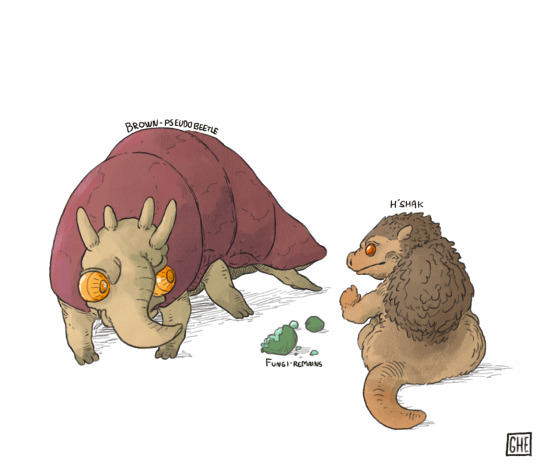
Rise of a landfish. This is how we call an event that continued throughout several millions of years, when the species of animals from the depths of the oceans, supplanted the pseudo crustaceans in an ever changing ecosystems of Mars. It all started from the bottom. Wnen several amphibian species left the dried wetlands in river deltas, and ventured forth on the ground. When the small burrow creatures like h’shak and the tree-climbers started to overtake the niches of a smaller herbivore pseudo crustaceans. With a passage of time the biggest, the ferocious ones among pseudo crustaceans will die out, hunted, and not being able to survive in an environment changed by advances of T’kar, leaving only gigantic exoskeletons after them. T’kar which appeared in the later part of the pseudo crustaceans era, and yet witnessed them, will stick around for sometime after, building several civilisations, of industrial type, and cutting out the Forrest’s which provided them with much needed oxygen. Those civilisations in the end will turn into dust, and the remains of the T’kar folk will retreat into the depths of the relic-jungles, and the cave systems overgrown with fungi.
Speaking of land fish – the first ones to leave the water, long time before anyone else – Mafas, they haven’t disappeared, and stayed around right until, the end of Mars. With the advances in prolonging their lives, and a control of procreation, and urban development they managed to live in harmony with nature throughout the eons. They witnessed the rise of the first gigantic beetles, they witnessed how Rakk’at soared into the skies… How villages turned into the towns, and cities, and how those cities turned into dust, leaving only few of the remains from the insect civilisation, which Mafas preserved with sort of parental care. Yet having the magical power of immeasurable scale they felt like not having the right to try interfering with nature in a way it would be possible for them to save the ancient ecosystem. But Mafa were here for longer than anyone else and they knew that with every ebb there is a high tide, and eventually the Mars will bloom with the new life. The explosion of Land Fish will bring around a new age of biodiversity. Unfortunately for Martians the last ones, as the plane5 won’t be able to heal itself, after the scourges, it’s new inhabitants – worm blooded, much more cruel, and versitile ones will bring upon it…
#song of eons#fantasy#illustration#fantasy universe#worldbuilding#fantasy world#science fiction#creature design#art#procreate#my art#fantasy creature#i guess I went overly dramatic for the description of this illustration#like holly hells#i guess I need to make several illustrations of T’kar advancements
8 notes
·
View notes
Text
Europa is enveloped in a thick coat of water ice. (Some other moons in our solar system have ice made of methane and nitrogen—the cosmos is a weird place.) The criss-crossing lines visible in the new pictures are actually cracks and fissures in that frozen exterior. Scientists suspect that they’re caused by the stretching and squashing that Europa experiences as it orbits giant Jupiter. The moon’s terrain is sprinkled with chemical compounds such as sodium chloride and magnesium sulfate—more commonly known to Earthlings as table salt and Epsom salt—and they could indicate briny waters below.
Scientists got their best evidence that a Europan ocean might exist two decades ago, when that earlier NASA spacecraft detected a magnetic connection between Europa and Jupiter that could easily be explained by the presence of a salty, global sea. This deep into the solar system, Europa’s underground ocean wouldn’t feel the warmth of the sun; it would stay liquid because of Jupiter’s gravitational tugging. In recent years, telescopes have detected signs of plumes of water vapor spewing out of the cracks and into space. Scientists believe that Europa’s ocean could be as old as the moon itself, about 4 billion years or so, which would give life plenty of time and a stable environment in which to evolve, Phillips said.
The data suggest that Europa has a rocky mantle—the layer between the moon’s crust and core—and when rock and water come together, magical things can happen: Chemical interactions between them are known to produce hydrogen-rich materials for tiny creatures to metabolize. “On our own planet, hydrothermal systems at the seafloor provide energy for communities of microorganisms,” Samantha Trumbo, a planetary scientist at Cornell who studies icy ocean worlds like Europa, told me.
The upcoming NASA mission, named Clipper—a nod to the speedy, lightweight vessels favored by 19th-century merchants—will study nearly every bit of the Europan surface. If it gets lucky, the spacecraft could fly through some plume particles, take a sip, and analyze the contents. Alyssa Rhoden, a planetary geophysicist at the Southwest Research Institute who studies Europa, is most excited about a Clipper instrument designed to detect warmer-than-usual spots on the moon’s surface. “When you look at Europa’s surface, you can see a lot of pits where the surface seems to have dropped down a little bit, places where the surface has been disrupted,” Rhoden told me. “We think that that’s happening from heating coming from below.” That signature could simply indicate the presence of melted bits of ice near the frigid crust—or it could mean a roiling sea has floated toward the surface, perhaps bringing any tiny inhabitants with it.
The Clipper mission is not meant to find definitive proof that life exists on Europa, only explore whether the moon has the right conditions and chemistry to make life possible. Evidence of life will require more missions, guided by Clipper’s data, that could land on the Europan surface and drill into the ice. NASA is also searching for life elsewhere in the solar system, notably on Mars, where a rover is collecting samples from a dried-up river delta. But Europa is a more tantalizing target, and so are the other ocean moons sprinkled across the solar system, such as Enceladus and Titan, which orbit Saturn, and Triton, around Neptune. The Mars mission is designed to search for signs of fossilized life that existed several billion years ago, when water once flowed on the planet. “It’s quite possible that Mars could have had life in the past, in a warmer-weather era, and it’s possible that there are subsurface pockets on Mars that could have remnants of this living biosphere,” Phillips said. “But on somewhere like Europa, life could exist there now.”
And what might humanity, by way of carefully engineered machines, find on Europa, once we’ve figured out which melty bits to inspect? “I would love for there to be Europan whales swimming around in that ocean,” Phillips said with a laugh. But alien life, if it exists, is likely to be small and simple. Energy sources are limited in the Europan depths, and scientists don’t think the environment can support the development of more complex organisms, Phillips said. Still, even the discovery of a single microbe would mark an explosive event in human history. It would mean that life had managed to spring up in two different places around the same star—in a universe absolutely brimming with stars. If it happened more than once here, in our own solar system, it’s likely happened elsewhere in the cosmos, around someone else’s sun. This is why scientists are so eager to catch a glimpse of Europa, and prepare as much as they can for the exploration to come. “We all want it to be water,” Rhoden said. “We all want it to be a cool plumbing system in the shell with lots of activity, and someday we’ll get down there and find little Europan sea urchins clinging to the bottom of the ice.”
— There’s Hope for Life on Europa, a Distant Moon
#marina koren#astronomy#space exploration#science#planetary science#ecology#oceanology#chemistry#geophysics#extraterrestrial life#biology#microbiology#jupiter#europa#water#nasa#europa clipper#samantha trumbo#alyssa rhoden#cynthia phillips
3 notes
·
View notes
Link
Mars' oceans, lakes, and rivers are long gone. They've left behind evidence of their time here in river channels, deltas, paleolakes, and other features. The water's existence isn't a mystery, but its whereabouts is. Did it disappear into space, or did it retreat into underground aquifers?
0 notes
Text

fucking losing it currently because they found cross bedding on mars
#personal#stemposting#LJSTEN#THAT MEANS THERE WAS LIQUID WATER ON THE SURFACE#AND ENOUGH OF IT TO 1) FORM SEDIMENTARY ROCKS AND 2) LEAVE RIPPLES IN THEM!!!#MARS RIVERS! MARS DELTAS! MARS OCEANS
52 notes
·
View notes
Text
i wanted to look at the symbolism of the ocean in disco elysium because it features so prominently in the setting. insulinde being an isola comprised of islands, martinaise as a port town financially anchored by its ocean trade. the divisions brought by water that we see in the geography: how the canal separates the working district of martinaise from the even poorer, commerce-less village-- how the river esperance separates the worst ghettos of revachol and jamrock from the more rebuilt and financially stable districts-- how, for example, lilienne looks across the bay of revachol to the wealthy district of la delta, a poignant moment of separation between someone desperately poor and the towers of wealth built out of the ruins of revachol. we see water, and often the sea specifically, acting as a divider in various contexts.
the ocean of time and distance that separates dora and harry, that separates klaasje from oranje:



then, further into the idea of the ocean as representative of time: in various contexts i see the ocean as representing the past. memory residing under the waves, and each of us living above water-- in the present-- but often still helpless to the tides when we’re not careful. to me this is cemented by the implication that the pale is commonly theorized as an *outer ocean* (juxtaposed with harry’s introspective skill, inland empire!!): the pale is the past, and if the pale is seen as an outer ocean, then right there is a tangible connection between the two. memory and the past as an ocean, dangerous if you don’t respect its power, but ultimately navigable. there is frequent reference made to the fact that the bombed ruins of martinaise are sinking or lost into the ocean, lost to the past, now only memory.
and harry, who is living in the past and being consumed by nostalgia like a rot, drives his car into the ocean. harry’s badge, which is conflated with his identity in the aftermath of his amnesia, was underwater before he pulled it from the car: until he got it, his entire identity was lost with his memory in the past. klaasje’s documents, too, presumed lost to the ocean, a loss of who she was or claimed to be (until you meet the phasmid). lilienne’s husband was lost to the waves, and in the same lines she’ll dismiss your concerns-- he’s in the past now, she’s really not too upset. the cleaning lady, abandoned by the world, who has only her own memories for company in her sea-beaten room. in the context of ruby’s near-suicide in the shack, how inland specifies how the “waves had calmed” as she put the gun away: ruby distancing herself from the past that she thinks is chasing her to form a better plan. the working-class husband, who, had his corpse fallen through the boardwalk into the ocean, would have been lost to the past, living only in the memory of billie and their daughters.














for me, the final dream had some of the heaviest but most subtle inclusions of the ocean symbolism. it’s brought on by looking into the ocean around the seafort and takes place under the ocean somewhere. even before the dream, dora is alluded to in the context of the sea. she moved across the ocean and now, to him, she’s lost under it. she’s trapped in his memory.


where we see things half-submerged or partially oceanic, we see a bridge between the past and the present being represented. something partially lost to the past but still with a foot in the here and now. harry’s half-sunken car, in part a representation of his career: part of his past, yes, but still very much in his present. one of the primary spiritual practices we hear of is the volta do mar: originally a palefarer’s practice to keep them grounded in an onslaught by the past, and its meaning is *return from the sea*. when harry tries to turn back time, he wants to go back to a time when the sun had not yet sunk into the sea-- when the light in his life didn’t reside solely in the past.





also in this context, something that really struck me was how harry will sometimes think of himself in the context of the sea. first is the sea monster thought, brought about by the broken plaza: him as a creature submerged in the past, terrorizing the present. and seafaring brought up to represent a kind of compromise between living in the present and acknowledging the draw of nostalgia. even joyce in her limited knowledge of harry compares him to a “half-submerged ruin”. and when harry is prompted into introspection by the dros predicament, inland empire becomes the *inland sea*.





and i really want to make a final, individual point of this. the whirling-in-rags music is sea power’s song “fire escape in the sea”. there is an explicit reference made to the song by shivers as well, and i think the choice of this song is very intentional. the whirling-in-rags is where harry forgot his whole life, the whole world, and it’s where he wakes up and begins to piece it all back together. the whirling-in-rags is harry’s fire escape in the sea. his bridge between his past and his present, his last-ditch attempt at escape from the tortures of his subconscious.

(this is by no means exhaustive, there are a lot of other moments where the sea comes in, but i included the moments that spoke to me most. you’re welcome to add your own!)
#disco elysium#disco elysium meta#gen meta#hdb meta#kiwipost#i'm gonna see if i can go on mobile and edit the alt text in#if not i may rb with dialogue descriptions#anyway yeah. maybe this is nothing but it means something to ME. to me.#joyce and lilienne are the two people we see with boats#coincidentally the two who seem to have made peace with the past that led them here to this point in their lives.#also on the significance of it being a dockworkers' union in particular that we deal with.#it doesn't mean nothing. i swear there's something here#i also want to think about what it means for harry to be compared to several types of bird#in a context where the ocean represents the past#he's got the name of a hawk. his heraldic bird could be a cockatoo but also he can be compared to a seagull.#he destroys the stuffed skua. his old partner was jean-heron.#much to consider there.#will need to ruminate on that for a while.
423 notes
·
View notes
Text
Amazing Earth: Satellite Images from 2020
In the vastness of the universe, the life-bringing beauty of our home planet shines bright. During this tumultuous year, our satellites captured some pockets of peace, while documenting data and striking visuals of unprecedented natural disasters. As 2020 comes to a close, we’re diving into some of the devastation, wonders, and anomalies this year had to offer.
NASA’s fleet of Earth-observing satellites and instruments on the International Space Station unravel the complexities of the blue marble from a cosmic vantage point. These robotic scientists orbit our globe constantly, monitoring and notating changes, providing crucial information to researchers here on the ground.
Take a glance at 2020 through the lens of NASA satellites:
A Delta Oasis in Southeastern Kazakhstan
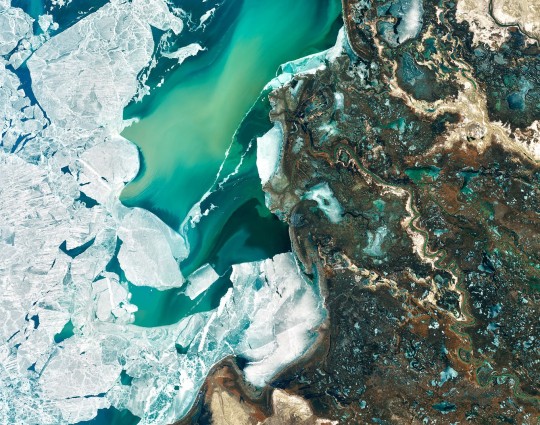
Seen from space, the icy Ili River Delta contrasts sharply with the beige expansive deserts of southeastern Kazakhstan.
When the Operational Land Imager (OLI) on Landsat 8 acquired this natural-color image on March 7, 2020, the delta was just starting to shake off the chill of winter. While many of the delta’s lakes and ponds were still frozen, the ice on Lake Balkhash was breaking up, revealing swirls of sediment and the shallow, sandy bed of the western part of the lake.
The expansive delta and estuary is an oasis for life year round. Hundreds of plant and animal species call it home, including dozens that are threatened or endangered.
Fires and Smoke Engulf Southeastern Australia

A record-setting and deadly fire season marred the beginning of the year in Australia. Residents of the southeastern part of the country told news media about daytime seeming to turn to night, as thick smoke filled the skies and intense fires drove people from their homes.
This natural-color image of Southeastern Australia was acquired on January 4, 2020, by the Moderate Resolution Imaging Spectroradiometer (MODIS) on NASA’s Aqua satellite. The smoke has a tan color, while clouds are bright white. It is likely that some of the white patches above the smoke are pyrocumulonimbus clouds—clouds created by the convection and heat rising from a fire.
Nighttime Images Capture Change in China

A team of scientists from NASA’s Goddard Space Flight Center (GSFC) and Universities Space Research Association (USRA) detected signs of the shutdown of business and transportation around Hubei province in central China. As reported by the U.S. State Department, Chinese authorities suspended air, road, and rail travel in the area and placed restrictions on other activities in late January 2020 in response to the COVID-19 outbreak in the region.
A research team analyzed images of Earth at night to decipher patterns of energy use, transportation, migration, and other economic and social activities. Data for the images were acquired with the Visible Infrared Imaging Radiometer Suite (VIIRS) on the NOAA–NASA Suomi NPP satellite (launched in 2011) and processed by GSFC and USRA scientists. VIIRS has a low-light sensor—the day/night band—that measures light emissions and reflections. This capability has made it possible to distinguish the intensity, types, and sources of lights and to observe how they change.
The Parched Paraná River
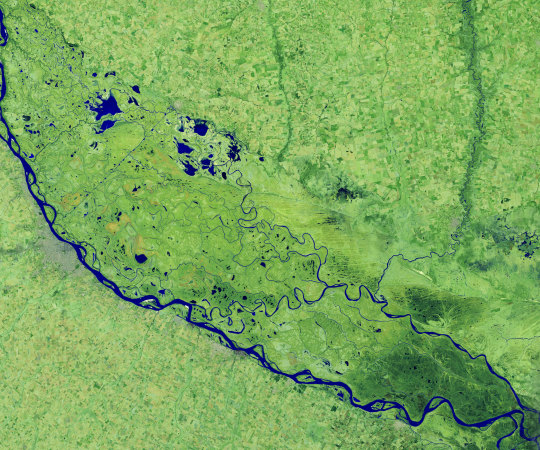
Though a seemingly serene oasis from above, there is more to this scene than meets the eye. On July 3, 2020, the Operational Land Imager (OLI) on Landsat 8 captured this false-color image of the river near Rosario, a key port city in Argentina. The combination of shortwave infrared and visible light makes it easier to distinguish between land and water. A prolonged period of unusually warm weather and drought in southern Brazil, Paraguay, and northern Argentina dropped the Paraná River to its lowest water levels in decades. The parched river basin has hampered shipping and contributed to an increase in fire activity in the delta and floodplain.
The drought has affected the region since early 2020, and low water levels have grounded several ships, and many vessels have had to reduce their cargo in order to navigate the river. With Rosario serving as the distribution hub for much of Argentina’s soy and other farm exports, low water levels have caused hundreds of millions of dollars in losses for the grain sector, according to news reports.
Historic Fires Devastate the U.S. Pacific Coast

Climate and fire scientists have long anticipated that fires in the U.S. West would grow larger, more intense, and more dangerous. But even the most experienced among them have been at a loss for words in describing the scope and intensity of the fires burning in West Coast states during September 2020.
Lightning initially triggered many of the fires, but it was unusual and extreme meteorological conditions that turned some of them into the worst conflagrations in the region in decades.
Throughout the outbreak, sensors like the Visible Infrared Imaging Radiometer Suite (VIIRS) and the Ozone Mapping and Profiler Suite (OMPS) on the NOAA-NASA Suomi NPP satellite collected daily images showing expansive, thick plumes of aerosol particles blowing throughout the U.S. West on a scale that satellites and scientists rarely see.
This image shows North America on September 9th, 2020, as a frontal boundary moved into the Great Basin and produced very high downslope winds along the mountains of Washington, Oregon, and California. The winds whipped up the fires, while a pyrocumulus cloud from the Bear fire in California injected smoke high into the atmosphere. The sum of these events was an extremely thick blanket of smoke along the West Coast.
The Sandy Great Bahama Bank
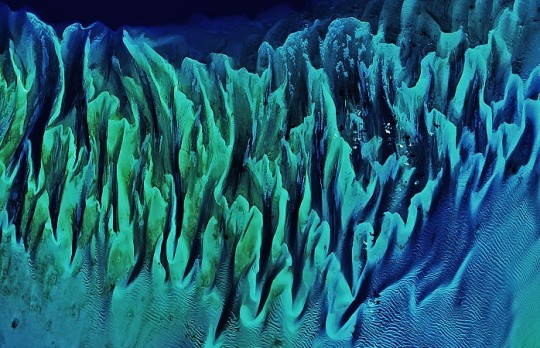
Though the bright blues of island waters are appreciated by many from a sea-level view, their true beauty is revealed when photographed from space. The underwater masterpiece photographed above is composed of sand dunes off the coast of the Bahamas.
The Great Bahama Bank was dry land during past ice ages, but it slowly submerged as sea levels rose. Today, the bank is covered by water, though it can be as shallow as two meters (seven feet) deep in places. The wave-shaped ripples in the image are sand on the seafloor. The curves follow the slopes of the dunes, which were likely shaped by a fairly strong current near the sea bottom. Sand and seagrass are present in different quantities and depths, giving the image it’s striking range of blues and greens.
This image was captured on February 15th, 2020, by Landsat 8, whose predecessor, Landsat 7, was the first land-use satellite to take images over coastal waters and the open ocean. Today, many satellites and research programs map and monitor coral reef systems, and marine scientists have a consistent way to observe where the reefs are and how they are faring.
Painting Pennsylvania Hills
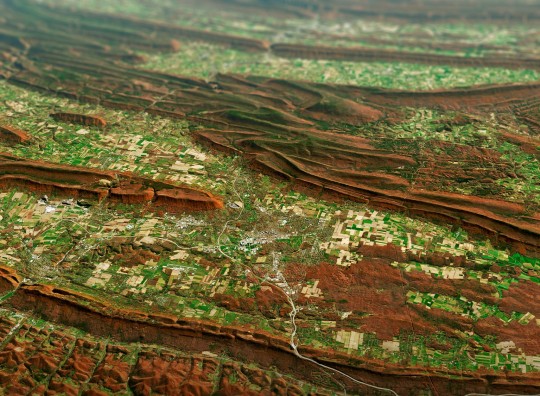
Along with the plentiful harvest of crops in North America, one of the gifts of Autumn is the gorgeous palette of colors created by the chemical transition and fall of leaves from deciduous trees.
The folded mountains of central Pennsylvania were past peak leaf-peeping season but still colorful when the Operational Land Imager (OLI) on the Landsat 8 satellite passed over on November 9, 2020. The natural-color image above shows the hilly region around State College, Pennsylvania overlaid on a digital elevation model to highlight the topography of the area.
The region of rolling hills and valleys is part of a geologic formation known as the Valley and Ridge Province that stretches from New York to Alabama. These prominent folds of rock were mostly raised up during several plate tectonic collisions and mountain-building episodes in the Ordovician Period and later in the creation of Pangea—when what is now North America was connected with Africa in a supercontinent. Those events created the long chain of the Appalachians, one of the oldest mountain ranges in the world.
A Dangerous Storm in the Night

Ominous and looming, a powerful storm hovered off the US coastline illuminated against the dark night hues.
The Visible Infrared Imaging Radiometer Suite (VIIRS) on NOAA-20 acquired this image of Hurricane Laura at 2:20 a.m. Central Daylight Time on August 26, 2020. Clouds are shown in infrared using brightness temperature data, which is useful for distinguishing cooler cloud structures from the warmer surface below. That data is overlaid on composite imagery of city lights from NASA’s Black Marble dataset.
Hurricane Laura was among the ten strongest hurricanes to ever make landfall in the United States. Forecasters had warned of a potentially devastating storm surge up to 20 feet along the coast, and the channel might have funneled that water far inland. It did not. The outcome was also a testament to strong forecasting and communication by the National Hurricane Center and local emergency management authorities in preparing the public for the hazards.
A Windbreak Grid in Hokkaido
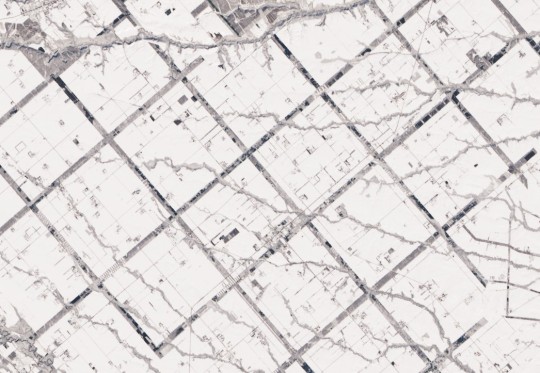
From above, the Konsen Plateau in eastern Hokkaido offers a remarkable sight: a massive grid that spreads across the rural landscape like a checkerboard, visible even under a blanket of snow. Photographed by the Operational Land Imager (OLI) on Landsat 8, this man-made design is not only aesthetically pleasing, it’s also an agricultural insulator.
The strips are forested windbreaks—180-meter (590-foot) wide rows of coniferous trees that help shelter grasslands and animals from Hokkaido’s sometimes harsh weather. In addition to blocking winds and blowing snow during frigid, foggy winters, they help prevent winds from scattering soil and manure during the warmer months in this major dairy farming region of Japan.
Shadows from a Solar Eclipse
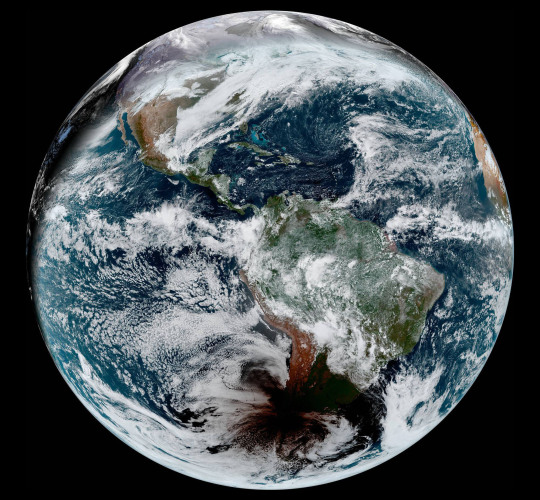
Formidable, rare, and awe-inspiring — the first and only total solar eclipse of 2020 occurred on December 14, with the path of totality stretching from the equatorial Pacific to the South Atlantic and passing through southern Argentina and Chile as shown in the lower half of the image above. The Advanced Baseline Imager (ABI) on Geostationary Operational Environmental Satellite 16 (GOES-16) captured these images of the Moon’s shadow crossing the face of Earth.
The “path of totality” (umbral path) for the eclipse was roughly 90 kilometers (60 miles) wide and passed across South America from Saavedra, Chile, to Salina del Eje, Argentina. While a total eclipse of the Sun occurs roughly every 18 months, seeing one from any particular location on Earth is rare. On average, a solar eclipse passes over the same parcel of land roughly every 375 years. The next total solar eclipse will occur on December 4, 2021 over Antarctica, and its next appearance over North America is projected for April 8, 2024.
For additional information and a look at more images like these visit NASA’s Earth Observatory.
Make sure to follow us on Tumblr for your regular dose of space: http://nasa.tumblr.com.
#NASA#Earth#science#earth pictures#planet earth#solar eclipse#eclipse#oceans#solar system#planets#space#satellite#stunning photos
2K notes
·
View notes
Text
What is in your itinerary?
Aries Ninth House/Mars in the Ninth House
Under the Australian sun, you will indulge in the ancient sands and mystical waters. You’ll stand and stare into the Indian ocean, peer into reefs of sharks and stingrays, look onto endless roads through the red desert, listen to the stories of dreamtime, sense old energies, old spirits, and fall in love with the down under.
Taurus Ninth House/Venus in the Ninth House
You’ll find luxury in France, where good food and wine, fashion, and art is celebrated. You’ll spend your mornings in Parisian cafés, your afternoons in trendy boutiques, and your nights in sweetly scented vineyards. You’ll ponder the meaning of beauty as you stand in cathedrals or in front of hundred year old paintings.
Gemini Ninth House/Mercury in the Ninth House
Beside the Atlantic Ocean, grey skyscrapers stand over the noisy, busy city of New York. You’ll be lured in by every “World’s Best,” dance at the most exclusive clubs, and stand at the top of the tallest towers. You’ll find beauty in this city’s rugged imperfection and vibrance with its people.
Cancer Ninth House/Moon in the Ninth House
Home of the world’s roots, you’ll find yourself tracing back to ancient lands in Botswana. You’ll find yourself reflecting over a lively delta of birds, elephants, and hippos as the sun sets and the moon begins to greet you. You’ll raise your own sun, a campfire, where stories can be told. Listen to what nurtured this land for thousands of years and what traditions have been sacredly preserved.
Leo Ninth House/Sun in the Ninth House
The Polynesian triangle that holds islands of beauty afloat, you will discover vibrant greens coving pools of blue. Rigid, hot rocks mantel ancient statues. Plump fruit hanging from every tree. Sunsets that are celebrated with dance. You’ll forget about the Western world on these happy, secret islands.
Virgo Ninth House/Vesta in the Ninth House
The hidden gems that lie within India, such as the Ajanta Caves, reveal elaborate religious history. Peregrinating the whole country, you’ll discover intricate architecture, diverse culture, remote beaches, and rolling hills. Realign with what matters in the Parvati valley with mountain views and spiced tea.
Libra Ninth House/Juno in the Ninth House
Far from the capital, Tokyo, you’ll find peace and simplicity in rural Japan. You’ll wander through forests greeted by torii and guarded by shrines. This island accentuates the beauty in ceremony and the comfort of a familiar meal. During a week in spring, you’ll drink underneath a cherry tree and witness the wind carry its petals.
Scorpio Ninth House/Pluto in the Ninth House
In the deserts of Jordan, you’ll float in the Dead Sea, explore sandstone ruins, and walk with camels through dunes and canyons. You’ll feel the energy of ancient traders and travels who once navigated through this country. Sunsets here paint the sky pink over the orange Petra.
Sagittarius Ninth House/Jupiter in the Ninth House
The old worlds that sit at the Mediterranean Sea who fascinate the endlessly curious. Where philosophers pondered in Athens, where pharaohs reigned along the Nile, where Gods blessed the lands of Turkey and Israel. You’ll embrace the ancient walls and scriptures, the magickal textiles and wares, and the religiousness, culture, and knowledge.
Capricorn Ninth House/Saturn in the Ninth House
In the chill of Scandinavian air, you will look up at auroras that dance over Iceland, Norway, Sweden, and Denmark. Beneath your feet is volcanic earth, fresh snow, and the footprints of reindeer herders. You’ll feel warmed by valleys, the traditional art, the culture, and the sound of ancient joik.
Aquarius Ninth House/Uranus in the Ninth House
Within the other worldly landscapes of Russia, you’ll find solitude and rediscover how large this planet is. You’ll be in awe at the active volcanos in Kamchatka, the endless fields of ice around Siberia, and the beautiful architecture in Moscow and St. Petersburg. The geographical diversity of this alien world is yet to be known.
Pisces Ninth House/Neptune in the Ninth House
In the haunting and mysterious Northern Canada lies untouched or forgotten places. Fragrant pine trees conceal its silent world. You’ll find secret roads that lead to creeks, rivers, falls, relics, and old, forgotten mine towns. The very North faces the blackness of the Arctic Ocean. A lonely sight that makes you wonder if anyone else has stood where you have.
© 2021 – @star-astrology
372 notes
·
View notes
Text
How We Decided
The day after tomorrow- that is, February 18, 2021- the Perseverance rover will attempt to land on the surface of Mars. It will enter the planetary atmosphere at an acute angle, giving it as much time as possible to experience drag and slow down from orbital velocities. Because Mars’ air is so thin, and the rover is so heavy, this will fail- in the best case, Perseverance would still be going almost a thousand miles an hour when it impacts the surface. To help save itself, the craft will deploy a parachute of advanced design, seventy feet across and able to withstand supersonic velocities. This, too, will fail. Even with a parachute, there is simply not enough air between Perseverance and the Martian surface to slow it down all the way. So this is where the rockets kick in. Once air resistance slows the rover to a bit less than two hundred miles per hour, the heavy heat shield will be jettisoned, and a system of secondary rockets will fire against the direction of motion until it slows to near-hovering. In a final flourish, the rover will descend from the rocket-boosted frame on coiled springs, until it touches down in the western part of Jezero crater in the northern hemisphere of Mars.
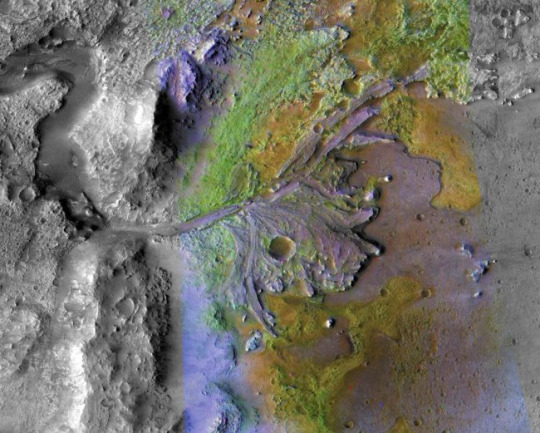
As it happens, Perseverance’s destination was one of the very last things we decided about it- not until the craft itself was fairly thoroughly engineered and designed. Formally, the decision was made by the mission directorate. In practice, they follow the consensus of the scientific community, which in turn hashes things out at a series of open-invitation workshops. Things began with a call for white papers- an open suggestion box, basically. In 2015, the first workshop narrowed things down from thirty serious proposals to eight candidates. In 2017, the second workshop further winnowed the list down to three. And in October of 2018, after three days of presentation, debate, and discussion, the final workshop selected Jezero Crater from these final three candidates using a simple vote of all attendees, and passed on the recommendation to the mission leads.
I haven’t been in the business for very long, so the final workshop was the only one of these where I actually participated. It wasn’t a close vote as such, and I didn’t break any ties, and technically we were just making a strongly worded suggestion. Nonetheless, my vote is one of the reasons why the Rover will be going to Jezero Crater instead of Syrtis Major or Gusev, and I think I’m entitled to feel ownership of this mission choice, just a little bit.
(This is, of course, terrifying.)
Having gone through the experience, there were a few surprises worth noting. The first was how small some of the numbers are here. The conference was not very large: only thirty proposals, debated by just a few hundred attendees. I’ve seen book review contests with more entries, and that are read by a wider audience. Which is to say, this is a situation that was, and is, extremely responsive to individual effort. In that small a room, populated by people that are philosophically committed to changing their minds when they see good evidence or a good argument, one person can stand up and change the future in a very real way.
The second surprise was the attendance requirements. Or rather, the lack thereof. The project is public, paid for by American taxpayers, to whom I am profoundly grateful. And one way the process reflected that public-spiritedness is that this is not a walled garden. A small attendance fee (iirc, $40?), and you’re in. You get a vote, if you want to use it. A few non-scientists even took us up on this; there’s one retiree (a former schoolteacher, I think) that’s attended every major conference I’ve been to in the last few years, and sets up a small table in the back with his home mineral collection just for fun. In practice this open-door policy is limited by the obscurity of the event itself; if you don’t move in research circles, you have to be something of a space exploration superfan to hear about it. Still, as symbols go, you could do worse.
And now that we’re coming up on the day itself, the same kind of public-facing mindset is making me think about why I was persuaded to vote for Jezero Crater, what it means to explore there, and how I’d justify that choice to those of you that made the ongoing discovery of Mars possible in the first place.
If you want to know what Perseverance is like, and what you can reasonably do with it, start with Curiosity- the two are built, more or less, on the same chassis. That means you have a mobile science lab about the size of a Volkswagon Beetle. Add some mechanical improvements (no more wheel punctures!) and a few bells and whistles (microphone! helicopter for some reason!). Trade out some of the scientific instruments- raman spectroscopy instead of a mass spectrometer, for example. And it’s got these:
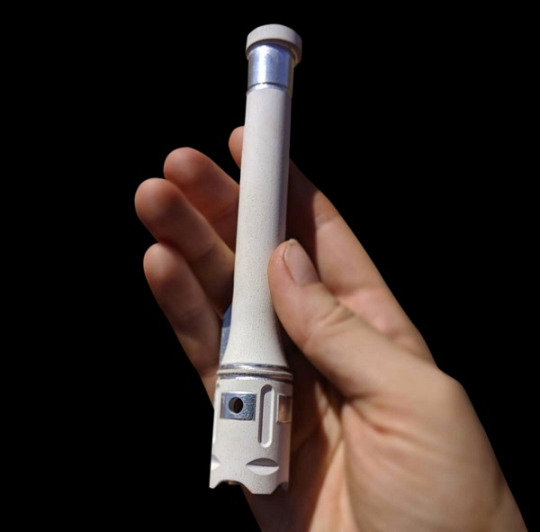
That, dear reader, is a sample return canister. Not to be returned immediately, alas, but to be returned nonetheless. One of Persevereance’s primary directives is to find interesting rocks, collect them, and leave them in place for a sample return mission in the early 30s. There’s a ton of work we can do in situ, but there’s even more we can do in a clean lab back home; things like isotopic analysis really need a much more controlled environment than you’ll get in the field. And so a major, major consideration is to optimize Perseverance’s landing site for cool rocks that we’d like to take back home.
The other thing that Perseverance is really good at is astrobiology. There’s no such thing as a life sign detector as such, but this rover represents an attempt to approach that ideal: instruments like SHERLOC and SuperCam are adept at finding organic compounds and fine-scale mineralogy and chemistry that might be influenced by microbial metabolism. This is a natural extension of what we’ve been learning so far: Spirit and Opportunity showed us that Mars formed under the influence of liquid water. Curiosity showed us that this was not just wet, but actively habitable: lakes and rivers at a neutral pH under a rich and temperate atmosphere. The next question along this line is the hardest, and the scariest: we know it was habitable, but was it inhabited?
If you’re like me, that question makes you feel weird. Collecting rocks is one thing, but a fossil? The mind rebels. We’ve spent the last two generations of space exploration tempering our expectations, reminding ourselves that the other worlds in our solar system are largely barren and dead, learning again and again how precious life is in the cosmos. It’s hard to get in the mindset of people back in the 40s and 50s who could, somewhat reasonably, imagine that Mars might not just host life but multicellular life, vegetation and robust macroscopic ecosystems. We look back at the science fiction of the era, swarthy soldiers hopping from planet to planet in silver rockets, and laugh at the naivete. A smile at the exuberance of youth, if we’re feeling generous. When we were first beginning, we may have imagined ancient canals on Mars and crystal cities on Venus, but that was when space was a blank canvas for us to paint our fantasies. We’ve learned so much since then, and if it was less fun, at least it was true. We did the hard thing and accepted reality over fantasy. We accept that extraterrestrial environments are hostile to life- cratered, silent, and still. We’re grownups now.
Unless…
Unless.
Imagine that we were born just a bit earlier. Say, three and a half billion years or so. We raise our telescopes to the sky, and we see a sister-planet. Not red, but white and blue, with an atmosphere full of clouds and multiple large bodies of water scattered across its surface, prominent ice caps and snow-capped highlands, rivers tracing their way down to the lowlands in the north. (Maybe the water is all under the ice, not open to the air at the surface; maybe the liquid pools are small and limited to craters, not feeding a large ocean.) Sober scientists might have suggested we shouldn’t get our hopes up too much- after all, the gravity is much lower, there’s no tectonic recycling, and there’s no protective magnetosphere. But is sterility really the default assumption we should be making here? Is ‘we are alone in the cosmos’ really the most sane conclusion to draw from this situation? Is it not worth, perhaps, sending a rover to go see?
We’ve adapted our sensibilities to a dead solar system because in the moment we’re looking, it kind of is. We’re hopeful for the icy moons- and the evidence keeps mounting there as well- but the terrestrial planets are a grim reminder of the fragility and contingency of our own world. The thing is, the more we learn, the more we discover that we’re a bit late to a very, very interesting party. Venus is a hellscape, but it probably didn’t start that way. Mars is a desert, but once it was an oasis. What makes Earth special among the terrestrial worlds isn’t that it developed a temperate climate, but that it kept a temperate climate for more than four billion years. Stability, not habitability, is the party trick that makes us unique in the solar system. And if we’re really committed to being grownups, to accepting what’s real instead of what’s easy, we have to learn that lesson too.
And life does not need four billion years to begin. Not even close.
That brings us to Jezero Crater. The most interesting feature here is a large river delta- based on some clever geology, we’re pretty sure that a large river emptied into the crater during Mars’ wet period. When the rapidly-flowing water hit the still water of Lake Jezero, the loose sediments being carried along the current all fell out of suspension at this place, forming a large pile of detritus at the mouth of the river that accumulated over the lifetime of the system. Even more interesting, check out this geologic map:
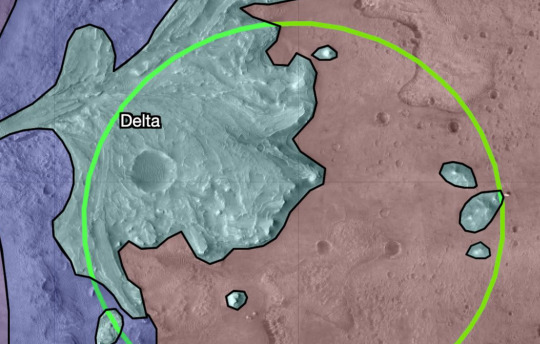
See those tiny teal deposits to the right side of the image? Those are also river delta deposits. Which means the thing labeled ‘delta’ on this map isn’t the original extent- it used to be much, much larger, at least twice as wide. Which also means that the outer edge of the ‘delta’ that we see here in this image is actually an erosional surface, and we get a natural cross-section of the thing with the oldest deposits at the bottom and the youngest at the top, just before Mars lost its hydrosphere. By climbing the outer edge, we can move through time across a large fraction of the habitable period.
Here’s another image I’d like you to see:
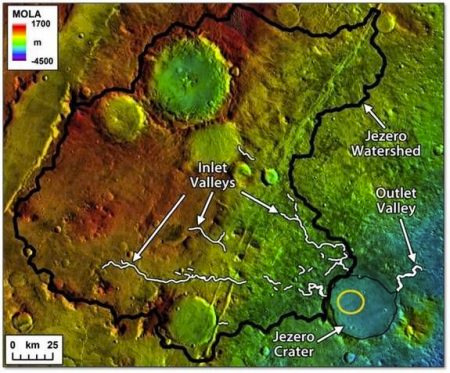
The crater I’ve been showing you is the small circle in the lower right- color is elevation, covering a span of about 5 km. The black line is the watershed of that river, the region of Mars that channeled water to the delta. In other words, the river delta collects sediments- and potentially, biosignatures- from a region hundreds of kilometers in diameter, and gathers them all in one place, neatly sorted by time.
For this reason, ancient deltas on Earth are a favorite of paleontologists. In addition to being comfortably wet and active itself- plenty of access to biologically important nutrients, fresh supplies of liquid water, and a nice dynamic environment- deltas do the legwork for us. Rather than exploring a huge fraction of the planet with a tiny rover, hoping that we stumble upon an ancient life sign, we can position ourselves at the mouth of the proverbial fire hose and let life come to us.
This does come with some tradeoffs. Most importantly, whatever we find, we won’t know the original geologic setting. If we find an unambiguous fossil of some kind- a microbial mat, perhaps- then we’ll know less than if we’d found it in its original home. And if we don’t find life, then the samples we take will be similarly uncertain. They’ll be defined in time, at least relative to one another, but not in space. In the case of life signs, this is an important caveat, but the bare fact of proving that extraterrestrial life exists is sufficiently monumental that it’s still a secondary concern. But if we’re just talking about geology, that’s a hard thing to lose; that terrifying multi-stage descent isn’t the only risk we’re taking. We’re leaning into the astrobiology mission hard with this one.
And the search for life is, in itself, fraught. That’s putting it mildly. There’s every chance that any evidence that’s even slightly marginal is going to touch off decades of debate, rather than being some kind of slam-dunk. As it should! Life is such a fuzzy concept, and such an important concept, that it should absolutely be held to the highest degree of scrutiny we can muster. This is why it matters that Perseverance includes sample return- in the highly likely case that the findings are disputed, we’ll hopefully have the chance to subject those samples to the highest degrees of scrutiny. So it feels like the right time to go hunting.
On top of that, there’s the ‘evidence of absence’ problem. Strong biosignatures update our priors very hard in the direction of life on Mars. But what is the correct amount of evidence necessary to convince us that Mars never was alive? I’m not sure, but failure to find microbial mats in Jezero probably isn’t enough. So the search for life can succeed, but if it ‘fails’ that doesn’t necessarily teach us much; the best experiments teach you something no matter what, and ideally a commitment this large would meet that standard. This is, more or less, baked into the search for extraterrestrial life, and there aren’t too many ways out from under that problem.
That said, Jezero in particular has some compensation. As I mentioned, we’re collecting a lot of good data regardless; and even without the gologic context, there’s a ton of opportunity to sample different minerals and how they formed, and get a nice broad sample of the Martian surface over time. And, even better, here’s the location of another interesting potential field site, in northeast Syrtis:
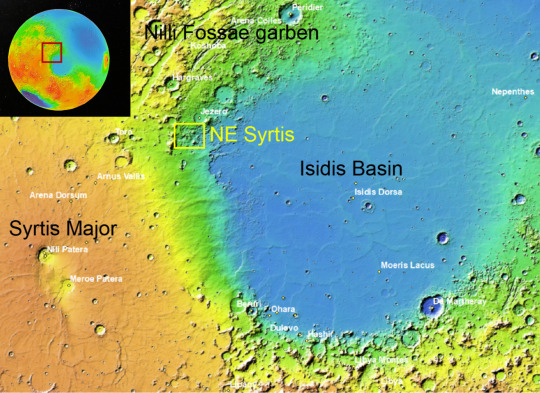
Note the proximity to Jezero crater! And Syrtis is also a fantastic candidate for a sample return mission. It has exposed mesas with layered outcrops going all the way back to the earliest days of Mars, and extending (potentially) through many of the most interesting periods. Now, these are not ideal for the search for life, although they’d give us a ton of technical data about surface chemistry and the behavior of the atmosphere during the early, wet periods; it would go a long way towards resolving arguments about the temperature of the early Martian climate, for example, or tracing the early destabilization and loss of the magnetosphere while teaching us loads about the planet’s core.
Those mesas are still pretty far away. Too far, probably, for a sensible rover lifespan to make it all the way there. But there’s a plan- called the ‘Midway’ route, as a nod to the compromise nature of it. See, halfway between Jezero and these mesas, there are a lot of banded rocks that look suspiciously like they’re sourced from the table mesas in Syrtis. And those, we can get to, maybe. If we call a specific deadline on looking for life in Jezero, then we can pivot to Midway and hopefully take a really deep look. So, in the end, we’re going hard for astrobiology research, but we’re not going all-in.
The importance of the search for life is… well, there are a lot of people out there, and we enter the world in a lot of different ways. Most of us agree that the existence of extraterrestrial life would be a Big Deal, and we tend to have a lot of different reasons for that. It’s not a bad subject for a future post or three, in fact. But there’s one thing lurking in the back of my head that’s a non-obvious reason to go looking. This wasn’t discussed at the workshop particularly, but it fed into my vote somewhat. Check the logic of this for me, see if it makes sense:
Worrying about existential risks, we sometimes talk about the ‘great filter’. That is, the mysterious phenomenon which explains the lack of extraterrestrial civilizations reaching out to us. Now, maybe we’re in a zoo or a preserve or something, and intelligences are out there watching after all; maybe the Earth really is the center of the cosmos, because of the simulation hypothesis or the various religious explanations. There’s no real way to know for sure at this point. But consider the space of very real possibilities where the universe actually is material, and actually is mostly barren. Why?
Stepping through the sequence, it might be that abiogenesis is really hard- going from a temperate world to a living one is almost (but not quite) impossible. Maybe there’s some hurdle to clear between genesis and encephalization. Maybe, given encephalization, civilization and tool-use are almost impossible. Or maybe there are many civilizations like ours, and the great filter is ahead of us- it is almost impossible for technological civilizations not to self-destruct or turn in to lotus-eaters before they reach interstellar civilization. There are a lot of possibilities for the filter, and for present purposes we’ll divide them into two categories: those which we would have already passed, and those which are in our future.
And here’s the thing: for each possibility we can exclude from the great filter, all the other possibilities increase commensurately, becoming more likely in our estimation. (Assuming the exclusion is ‘clean’ and doesn’t favor some other possibility, that is.) Given that the silence continues, if we could somehow prove that technological self-destruction isn’t a big risk, that would commensurately increase our guesses about how hard abiogenesis is.
Life on Mars, especially if we could be very sure that it evolved independently of Earth life, would be a strong argument against the difficulty of abiogenesis. One biosphere in the solar system, and nowhere else, might be down to luck. The one biosphere has to be somewhere, right? Two in the solar system, and nowhere else, is a good bit less reasonable. If we find a second genesis on Mars, then we’ve learned that life is not rare. That the hundreds of billions of stars in the Milky Way are likely host to many billions of different living (or at least once-living) worlds.
And as wonderful as that news is, as much as it makes me so happy that I literally had to take a second to cry on my bed for a bit, it also makes the great silence much, much scarier. Today, we can reassure ourselves by saying that life may be rare in the universe. But what if it isn’t? If the cosmos is full of life, but not full of thought, then…
If this is the case, we need to know. We need to know as soon as possible, and we need to know it while we’re engaged in the great project of technological development and moral progress. It’s easy to imagine that this particular mission is one that can be framed in purely positive terms- the joy of discovery, the vastness of truth, the love of how things might be. But I do also have this sense of civilizational fragility, you know? And understanding the risks that we face and the chances we’re taking- that’s not idle curiosity. That’s genuinely urgent.
212 notes
·
View notes
Text
Spanish Vocabulary - Nautical Words
Obviously I can’t list every single nautical word in Spanish, but I’m going to include some of the most common words related to ships/sailing. Nautical words in general are a little more on the esoteric side, so I’m going for what you’d find most useful and possibly something you’d say or use in real life.
Something important to note is that the line between “boat” and “ship” in English is more clear cut. Spanish tends to use el barco and la nave almost interchangeably, but a very large ship is most likely to be el navío or el buque
el barco = ship el barco de vapor = steamship
el navío = vessel / ship (large)
el buque = large ship [implied to be a large ship with decks] / vessel
la barca = rowboat
el bote = boat (often small) el bote de remos = rowboat [sometimes referred to as a “dinghy” in some cases]
la canoa = canoe
el velero = sailboat el barco de vela = sailboat [lit. “boat of sail”]
el remolcador = tugboat
el bote salvavidas = lifeboat / raft, life raft
la balsa = raft
el (barco) pesquero / el barco de pesca = fishing boat
la fragata = frigate
el buque de guerra = warship [in some context “man-o’-war” for very large ships with lots of cannons] el barco de guerra = battleship [sometimes used as buque de guerra depending on implied size]
el carguero = freight ship
el crucero = cruise ship
el acorazado = dreadnought
el yate = yacht
el submarino = submarine submarino/a = underwater
la goleta = schooner
la embarcación = vessel, “watercraft” [the umbrella term for any kind of ship, sort of like how an “aircraft” could include any kind of “plane” or “helicopter” etc]
la marina = navy la armada = navy / armada
la flota = fleet
la proa = prow / bow, front of the ship el castillo de proa = forecastle [sometimes just called a castillo which is “castle”; worth noting that in English “forecastle” is pronounced like “folk-sul” because English]
la popa = poop deck / stern, back of the ship el castillo de popa = aftercastle [sometimes has the name el alcázar which literally means something like “fortress”]
a proa y popa = “fore and aft”
el estribor = starboard, right side of a ship a estribor = to starboard, to the right
el babor = port, left side of a ship a babor = to port, to the left
la vela = sail [also “candle”, in a different context]
el mástil = mast
la quilla = keel
la atalaya = crow’s nest [lit. “lookout” or “watchtower”, sometimes la cofa] el punto de vigía = lookout (spot)
el casco = hull [also “helmet”, in a different context]
el puente de mando = bridge [as in “command bridge” or “command deck”, sometimes understood as “cockpit”]
la tripulación = crew
el/la tripulante = crew member
el remero, la remera = rower, oarsman/oarswoman
el alojamiento = quarters, lodging la cubierta de alojamiento de la tripulación = crew quarters
la cubierta = deck
la cocina = kitchen [on a ship called a “galley”] el galley = galley, kitchens
la sala de máquinas = engine room [lit. “machine room”]
el motor = engine
el carbón = coal
el mamparo = bulkhead
la escotilla = hatch
la red = net
la ventanilla = porthole [it literally means “little window” but I’ve also seen el ojo de buey which is literally “ox-eye”]
el mar = sea [sometimes la mar in older works or for poetic things] la alta mar = the high seas en alta mar = on the high seas
el agua = water [technically feminine in Spanish, but takes masculine article el]
el puerto = port [sometimes “harbor”]
el muelle / los muelles = wharf, docks
la bahía = bay
el arrecife = reef
la isla = island el islote = islet, small island
la arena = sand
la orilla = shore
la costa = coast costal = coastal
el borde = edge
la margen = edge, bank la margen del río = riverbank [margen can be masculine or feminine though la margen is more common for talking about rivers, while el margen is more common for “the margin” as far as the edge of a piece of paper or “margin for error” etc.]
la brújula = compass
derecho/a = right a la derecha = to the right a la diestra = to the right [old-fashioned]
izquierdo/a = left a la izquierda = to the left a la siniestra = to the left [old-fashioned]
por doquier = “all over the place”, “every which way” [shortened form of por dondequiera]
a diestra y siniestra = “right and left”, “all over the place”
de ida = one-way (trip)
de vuelta = return (trip)
de ida y vuelta = round trip
el pasaje = passage el pasajero, la pasajera = passenger
el viaje = voyage, journey, trip, travel
el viajero, la viajera = traveler
(el) norte = north
(el) sur = south
(el) este = east noreste = northeast sureste = southeast
(el) oeste = west noroeste = northwest suroeste = southwest
oriental = eastern / easterly
occidental = western / westerly
el levante = the East / easterly [comes from levantar “to rise” as in “the sun RISES in the east”]
el poniente = the West / westerly [comes from poner “to set” as in “the sun SETS in the west”]
el timón = rudder / helm
el remo = oar
el ancla = anchor [technically feminine in Spanish, but takes masculine article el]
el comercio = trade, commerce
la mercancía = merchandise, things to sell las mercancías = wares
la carga = cargo / freight
el camarote = cabin, a room on a ship
la cabina = cabin, usually the captain’s room
el capitán, la capitana = captain
la marea = tide
la ola = wave
el oleaje = surf, surge, swell
el océano = ocean
el río = river
el lago = lake
el delta = river delta
la boca = mouth [as in anatomy or “mouth of a river”]
el charco = a pool (of water) [not to be confused with la piscina “swimming pool”]
profundo/a = profound / deep
poco profundo/a = shallow
la profundidad = depth las profundidades = “the deep”, “the depths”
la pesca = fishing
el buceo = diving, scuba diving [not “diving” as in the sport] el/la buzo = diver, scuba diver
mareado/a = dizzy, seasick
el polizón = stowaway
varado/a = marooned
el naufragio = shipwreck
náufrago/a = shipwrecked
el náufrago, la náufraga = survivor of a shipwreck, castaway
el viento = wind
la niebla = fog
la lluvia = rain
el trueno = thunder
la brisa = breeze
despejado/a = clear [as in “no clouds” or “nothing in the sky/water”]
la calma = calm calmado/a = calm, peaceful en calma = at rest, peaceful, calm
la ráfaga = gust of wind la racha (de viento) = gust
el rayo = bolt of lightning
el relámpago = lightning flash
la nube = cloud nublado/a = cloudy
la neblina = mist, haze
la bruma = thick fog (especially at sea) brumoso/a = foggy, hazy, murky
la tormenta = storm
el vendaval = strong wind, gale
la ventisca = blizzard [also means “gale” since it is related to “wind”, but usually a ventisca implies snow and strong wind with reduced visibility]
el hielo = ice
el granizo = hail
la granizada / la pedrisca = hailstorm
la tempestad = tempest, gale
la borrasca = squall
el huracán = hurricane
el tifón = typhoon
el ciclón = cyclone / tornado
rumbo a = en route to
ir = to go irse = to go (away) irse de vacaciones = to go on vacation
visitar = to visit, to tour
volver = to return
trabajar = to work
nadar = to swim
ahogarse = to drown
caer(se) = to fall caer por la borda = to fall overboard
volcarse = to capsize, to overturn
pescar = to fish
bucear = to go diving [as in “scuba diving”]
marearse = to get dizzy / to get seasick
navegar = to navigate, to sail
perder = to lose perderse = to get lost
zarpar = to set sail levar anclas = to weigh anchor
izar = to hoist (sails/flags)
arriar = to bring in (sails/flags)
trazar una ruta / trazar el curso = to chart a course, to chart a path
viajar = to travel viajar de ida = to make a one-way trip viajar de vuelta = to travel back, to return home viajar de ida y vuelta = to make a round trip viajar en barco = to travel by ship
transportar = to transport
llevar = to carry/to bring
embarcar(se) = to embark, to get on a ship
desembarcar(se) = to disembark, to get off a ship
1K notes
·
View notes
Photo

Meet Jezero Crater In a couple days, NASA is launching its second nuclear-powered, car-sized rover to Mars, aiming for a landing early next year in the area at the lower-center of this image. This is Jezero Crater, target for NASA's Perseverance Mars Rover.
This image combines several photographic techniques using data from the Mars Reconnaissance Orbiter Spacecraft. MRO contains a high-resolution camera that captured the overall image in black and white so that we could see the structure, and it also contains a spectrometer called CRISM that scans the surface for areas that absorb light at specific wavelengths – allowing it to characterize the presence and abundance of minerals that absorb light at those wavelengths. Certain CRISM absorbances have been mapped out as the colors on this image, allowing you to see the mineralogical and geological details of the structure.
If your first thought is that the target area in Jezero looks a lot like the Mississippi River birdsfoot delta shape, you’re exactly right. This area sure looks like a river delta – in fact, it is one of the best preserved delta shapes on Mars. It is known as the Western Delta, as it’s on the western side of Jezero Crater. The crater itself is found in Mars’s northern hemisphere, on the boundary between high ground in Mars’s southern hemisphere and the large, flatter lowlands in the northern hemisphere that scientists call the Isidis basin. Jezero also sits alongside a large volcanic structure called Syrtis Major and near a large fracture system called Nili Fossae that is thought to have formed from the stresses in the crust created by the growth of the volcano and the formation of the nearby crater. The colors on this image tell the story of the regional geology the rover will investigate. The yellow-orange units are rich in the minerals found in basaltic igneous rocks, like those erupted from volcanoes on Hawaii and Iceland. Much of the crater floor thus represents primary or near-primary igneous rock, and there are sand dunes visible in this image at the south that are made of these igneous minerals including mostly olivine. When the crater formed, it was first filled partially with igneous rocks, either impact melt from the crater forming or lava flows coming from the nearby volcanic complex. Eventually, there was enough water flowing through the system to erode some of these igneous minerals, sort them, and deposit them in the delta shape. The delta shape still has some of the reddish-tint associated with the igneous minerals, but it also has additional colors due to clay minerals. Clay minerals on Earth are found where there is substantial flowing water, and in this image clay-rich areas appear blue. So, the delta itself is a mixture of variable amounts of clay minerals, formed by alteration of igneous rocks by water, and reworked igneous minerals from the crater rim. Finally, Jezero contains some rocks we have almost never seen up close on Mars; carbonate minerals. Carbonates on Earth are found in a variety of settings, including lakes and oceans, and represent excellent places to find preserved fossil organic material because they can entomb and trap fossil remnants of life for billions of years. Carbonate rocks are one way to take carbon out of the atmosphere and lock it away, so growing carbonate minerals could be one factor in how Mars’s atmosphere lost its greenhouse effect and the planet froze. One carbonate-bearing outcrop was seen at Gusev crater by the rover Spirit, but she was unable to make it up to that outcrop before she was trapped, so it was never investigated up close. The carbonate rocks appear green in this image. They are found, as they are on Earth, near what was likely the shoreline of a lake that filled Jezero Crater. To make this geology, water entered Jezero, pooled there, began filling a lake, and sediments were dropped from that water flow to form the delta. The lake level reached high enough to burst out of Jezero Crater’s northern rim, allowing permanent flow through of water, unlike any other site we’ve visited on Mars – Gale Crater, where the Curiosity Rover landed, was an isolated lake, so water could not flow out through any other river. This is the area the Perseverance Rover is targeting for its landing. The goal is to land on the flat plains at the south, march across the delta and up to the crater rim, taking measurements and collecting and storing samples as it goes. This was a habitable environment, with water present long enough to shape the mineralogy of the shoreline and to grow a delta – at least tens of thousands of years. The hope is…if any rocks on Mars could preserve evidence of the existence of martian life, they should be in this photograph. -JBB Image source: https://www.jpl.nasa.gov/spaceimages/details.php?id=PIA23239 Paper with mineralogical details: https://www.sciencedirect.com/science/article/pii/S0019103518306067#f0105 Read more: https://www.planetary.org/blogs/emily-lakdawalla/2018/jezero-landing-site-mars-2020-rover.html
#science#mars#jezero crater#perseverance#rover#geology#chemistry#carbonate#clay#phyllosilicate#mineral#crism#mars reconnaissance Orbiter#ctx#context#camera#planetary science#nasa#the universe#the real universe
106 notes
·
View notes
Text

New SpaceTime out Monday
SpaceTime 20240819 Series 27 Episode 100
The origins of Stonehenge’s Alter Stone revealed
It’s long been considered an ancient astronomical calendar, now new research has revealed Stonehenge’s monumental six-tonne Altar Stone, long believed to originate from Wales, actually came from Scotland.




Perseverance begins the long climb up Jezero Crater’s Rim
After spending some two and a half years exploring Jezero Crater’s floor and river delta, NASA’s Mars Perseverance rover has now commenced its journey to an area where it will search for more discoveries that could rewrite Martian history.



Tomorrow’s full moon is a blue supermoon
Tomorrow morning’s full moon is not only a perigee or so called supermoon, it’s also a blue moon; the sturgeon moon; the red, corn, green corn, barley, herb, grain, and dog moon depending on your preferences.


The Science Report
Mpox starting to spread beyond Africa.

Australians living longer than people in other English speaking countries.
Increasing coastal erosion is reducing the Arctic Ocean’s ability to absorb carbon dioxide.
Skeptics guide to baby back cracking
SpaceTime covers the latest news in astronomy & space sciences.
The show is available every Monday, Wednesday and Friday through Apple Podcasts (itunes), Stitcher, Google Podcast, Pocketcasts, SoundCloud, Bitez.com, YouTube, your favourite podcast download provider, and from www.spacetimewithstuartgary.com
SpaceTime is also broadcast through the National Science Foundation on Science Zone Radio and on both i-heart Radio and Tune-In Radio.
SpaceTime daily news blog: http://spacetimewithstuartgary.tumblr.com/
SpaceTime facebook: www.facebook.com/spacetimewithstuartgary
SpaceTime Instagram @spacetimewithstuartgary
SpaceTime twitter feed @stuartgary
SpaceTime YouTube: @SpaceTimewithStuartGary
SpaceTime -- A brief history
SpaceTime is Australia’s most popular and respected astronomy and space science news program – averaging over two million downloads every year. We’re also number five in the United States. The show reports on the latest stories and discoveries making news in astronomy, space flight, and science. SpaceTime features weekly interviews with leading Australian scientists about their research. The show began life in 1995 as ‘StarStuff’ on the Australian Broadcasting Corporation’s (ABC) NewsRadio network. Award winning investigative reporter Stuart Gary created the program during more than fifteen years as NewsRadio’s evening anchor and Science Editor. Gary’s always loved science. He studied astronomy at university and was invited to undertake a PHD in astrophysics, but instead focused on his career in journalism and radio broadcasting. Gary’s radio career stretches back some 34 years including 26 at the ABC. He worked as an announcer and music DJ in commercial radio, before becoming a journalist and eventually joining ABC News and Current Affairs. He was part of the team that set up ABC NewsRadio and became one of its first on air presenters. When asked to put his science background to use, Gary developed StarStuff which he wrote, produced and hosted, consistently achieving 9 per cent of the national Australian radio audience based on the ABC’s Nielsen ratings survey figures for the five major Australian metro markets: Sydney, Melbourne, Brisbane, Adelaide, and Perth. The StarStuff podcast was published on line by ABC Science -- achieving over 1.3 million downloads annually. However, after some 20 years, the show finally wrapped up in December 2015 following ABC funding cuts, and a redirection of available finances to increase sports and horse racing coverage. Rather than continue with the ABC, Gary resigned so that he could keep the show going independently. StarStuff was rebranded as “SpaceTime”, with the first episode being broadcast in February 2016. Over the years, SpaceTime has grown, more than doubling its former ABC audience numbers and expanding to include new segments such as the Science Report -- which provides a wrap of general science news, weekly skeptical science features, special reports looking at the latest computer and technology news, and Skywatch – which provides a monthly guide to the night skies. The show is published three times weekly (every Monday, Wednesday and Friday) and available from the United States National Science Foundation on Science Zone Radio, and through both i-heart Radio and Tune-In Radio.
#science#space#astronomy#physics#news#nasa#astrophysics#esa#spacetimewithstuartgary#starstuff#spacetime#jwst#hubble space telescope#nasa photos
7 notes
·
View notes
Photo

HiPOD 16 May 2020: A Terraced Fan and Valley in a Crater
This image shows a terraced fan (center left) located adjacent to a short valley. Terraced fans are rare deposits on Mars: they have only been seen in a few dozen locations. On Earth, terraced fans are found in alluvial environments and in deltas. When water flowing down steep slopes, such as mountains or hills, encounters a flatter surface, the sediments carried by the water are deposited along the shallow slopes to form alluvial fans. Deltas can also produce terraced fans when water from rivers and streams meets oceans or lakes; a delta deposit results at the contact between the confined, fast-moving water (river/stream) and the open body of water (ocean/lake). The fact that this Martian terraced fan is found adjacent to a valley supports the hypothesis that water was the mechanism that transported and deposited the material that now forms the fan. It is unclear, however, if this fan formed in an alluvial or deltaic environment, or by some other process. ID: PSP_005583_1700 date: 5 October 2007 altitude: 259 km NASA/JPL/UArizona
50 notes
·
View notes